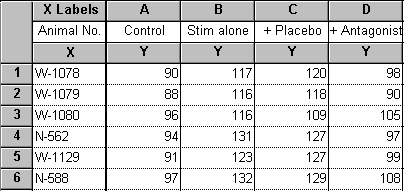Prism 3 -- One-Way ANOVA and Nonparametic Analyses
Step-by-Step Examples:
One-Way ANOVA and Nonparametic Analyses in Prism 3
Prism offers four ways to compare three or more sets of data that have been grouped by a single factor or category. The correct test depends upon (a) whether observations are matched by subject at each factor level and (b) whether you assume that measurements are drawn from a population that follows a normal (Gaussian) distribution.
|
Assume Gaussian distribution?
|
|||
|
Yes — Parametric test
|
No — Nonparametric test
|
||
| Repeated measures? |
No — data NOT matched by subject |
Regular ANOVA
|
Kruskal-Wallis test
|
|
Yes - data matched by subject |
Repeated-measures ANOVA
|
Friedman test
|
|
You don't have to memorize these assumptions; if you answer the questions above for your experiment, Prism will pick the correct test for you.
Following ANOVA, Prism can perform the Bonferroni, Tukey, [Student] Newman-Keuls, or Dunnett's post test. Following nonparametric analysis, Prism can perform Dunn's post test.
In this step-by-step example, we'll demonstrate a simple repeated-measures ANOVA followed by the Tukey post test, but we'll point out other options as we go. To learn more about analysis of variance, consult the ANOVA sections of Analyzing Data with GraphPad Prism (pdf) . If you have only two data groups to compare, try the step-by-step example on t tests. If you have more than two groups, but the data are grouped by two factors, refer to step-by-step on two-way ANOVA.
Enter the Data
When you launch Prism, the Welcome to Prism dialog appears. Choose to Create a new project and to Work independently. Uncheck the option box at the bottom of the Welcome dialog to Pop up new user hints.
In the lower half of the Welcome dialog, tell Prism how to format your data table. For the X column, select None (column graph). For the Y columns, choose A single column of values.

Suppose that you measure the mean blood pressures of six animals during a pre-treatment control period, then while administering a neural stimulus alone, in the presence of a placebo drug, and in the presence of a putative antagonist designed to inhibit the effect of neural stimulation. The data are matched, since each treatment is repeated in succession with each subject. Enter the data as shown below:
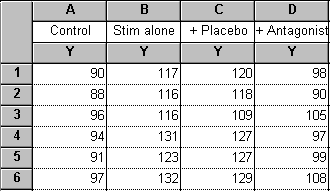
|
Generally, you'll omit the X column from your table when you intend to do one of the statistical analyses, but you don't have to. In this example, where treatments are repeated in the same subjects, you might find it useful to include an X column simply to keep track of subject identities. Below is a table formatted for text in the X column, into which animal tag numbers are then entered:
Prism will ignore the X column when doing a one-way ANOVA. There will be a difference in the default graph Prism produces-a column scatter plot without the X column vs. a bar chart with the X column, but you can easily change between graph types using Change.. Graph Type... |
|
You could also format your table for entry of mean, standard deviation or standard error, and N.
With this format, however, you can't perform a repeated-measures or nonparametric analyses, which require raw data. You can even format your table for entry of replicates, but in that case Prism will average the replicates and do the ANOVA on the means. |
Click on the yellow Graphs on the toolbar to view the column scatter plot that Prism has produced automatically. (Your graph may differ slightly in appearance from the illustration below-if you change the size or aspect ratio of the graph, Prism may change the lateral placement of the points within each column. Also, note that if your table includes an X column, Prism produces a bar graph).

If the baseline labels overlap, you can either reduce the font size of the labels (select the baseline and click the "-" button on the toolbar)...

...or select and drag to elongate the baseline.
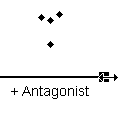
If you'd prefer, you can view a column bar graph instead by choosing Change.. Graph Type.. and choosing Column: Bars from the Graph Type drop-down list.

The error bars on this graph will show standard error (SEM) rather than standard deviation (SD) if that is the default setting in Prism (check this by choosing Tools.. Graph Options..). If you don't want to change the default setting to SD error bars but you do want the error bars to show SD on this graph, double-click on one of the bars to open the Format Columns dialog. Check the box labeled All, and choose to use SD as error values.
Note that this is a column bar graph. Our other step-by-step articles will help you to understand the distinction between a column bar graph and a regular bar graph.
Choose the Analysis and the Options
Click on the yellow Data tab to return to the data table. Click Analyze. In the Analyze Data dialog, select Statistical Analyses and One-way ANOVA (and nonparametric):

In the Parameters: ANOVA dialog box, you have two options for selecting the appropriate test. One option is to set the checkboxes according to (a) whether or not you have repeated measures and (b) whether or not you're assuming that measurements are drawn from a population that follows a Gaussian distribution. Prism provides the Test Name automatically:

The other option is to select the desired test from the Test Name drop-down box. In this case, Prism sets the checkboxes for you:

Next, choose the post test, if any. Set the checkbox to tell Prism whether or not to do a post test when, on the basis of the F statistic computed in the course of the ANOVA or nonparametric analysis, it does not find an overall difference in group means. Then choose the post test from the Test Name drop-down list.
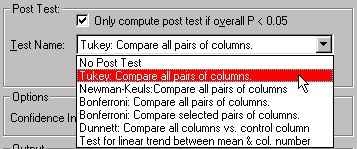
|
You can get help choosing both the basic analysis and the post test when you click Help me decide at the bottom of the Parameters dialog box.
|
Before leaving the Parameters dialog, check the box for the optional table of descriptive statistics.
View the Results
When you leave the Parameters dialog, Prism runs the analysis. The Results page for this example consists of three "views" (you can switch between views by changing the setting in the View drop-down box on the toolbar, and you can get help understanding the results by clicking the Interpret button.

Prism displays the Tabular results view first, indicating whether there is an overall difference in means...
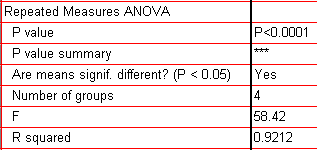
...and whether subject matching was effective (and hence increased the power to detect differences among means).

The ANOVA table is presented...

...as well as the post test results.

If Prism cannot do the analysis (e.g., you request a repeated-measures analysis, but data are missing from one or more cells), this is indicated on the Tabular results view also, and you are referred to the Commentary view.

![]()

Finally, choose the Column Statistics view.

Copyright (c) 2002, GraphPad Software Inc. All rights reserved.
















